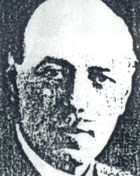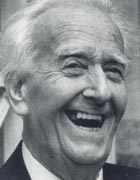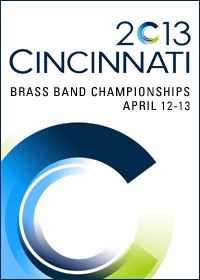2010 All England Masters International Championship - Test piece review
25-May-20104BR Editor Iwan Fox looks at the history of one of the great classics of the brass band repertoire.
 ’Epic’ (banding cognoscenti never ever refer to it in any other terms) is without doubt one of the truly iconic test pieces of banding history.
’Epic’ (banding cognoscenti never ever refer to it in any other terms) is without doubt one of the truly iconic test pieces of banding history.
Written in 1926, it was Percy Fletcher’s second work for the brass band contesting medium, following the pre First World War success of ‘Labour & Love’ at the National Finals in 1913.
Significant
The 13 year gap between the two works is significant.
Percy Eastman Fletcher (right), was born in Derby on 12th December 1879 and died on 10 December 1932 at the early age of 52.
And although his place in the British compositional hierarchy is no more than an intriguing footnote (he was referred to as ‘a theatre conductor and composer of popular music’ in his Musical Times obituary) his compositional output was extensive and varied, from marches to light opera and ‘An Epic Symphony’ remains one of the most significant in brass band history.
Western Front
Although Fletcher himself did not witness the horrors of the First World War at first hand, he would surely have experienced its catastrophic effects in his day to day life as Musical Director of His Majesty’s Theatre in London as tickets to see the musical comedy ‘Chu Chin Chow’ from 1916 onwards were eagerly sought by troops on leave from the Western Front.
Whereas ‘Labour & Love’ was idealistic, melodramatic and full of misplaced Edwardian bombast, ‘An Epic Symphony’ is a much darker, pragmatic, almost introspective work.
Whatever Fletcher’s own circumstances, the ‘War to end all Wars’ had certainly made its mark on the composer. Research shows that there were 43 Percy Fletcher’s listed serving in the Army in the First World War. Perhaps he knew that he as lucky he wasn’t one of them.
Elgarian
As Paul Hindmarsh says in the book, ‘The British Brass Band – A Musical and Social History’: “Fletcher used the ingredients and conventions of contesting to produce a work of character and technical sophistication. He turned the cadenzas and athletic solos into a prelude, called ‘Recitare’, comprising contrasting fanfares and recitatives. The central elegy, written as a musical war memorial, has an Elgarian breadth and poignancy about it.
The gentle undulating sighs of the horns, supported by the soft tread of the basses, make an especially haunting impression. Those same horns become like distant trumpets at the start of the ‘Heroic March’. This is a spirited amalgam of patriotic Elgar and Eric Coates, with an unexpected and very English sounding chorale at its climax.”
In the programme to the 1926 National Finals, no analysis of the work was given, although when it was used again in 1938 some details were provided, although the work was somewhat curtailed (bands were informed to start the final movement at figure 25)
The composition is described as being: ‘…not based on any poetic or historical programme, but is suggestive’ – rather reinforcing the earlier point that Fletcher perhaps did not see active service.
Resurfaced
The work resurfaced again at the Nationals in 1951, where a short analysis poetically described the central ‘Elegy’ as: ‘While at the contest the stirring martial passages will, without doubt, thrill to the core with their grandeur and nobility, I am anticipating that some of the widely different interpretations of this appealing second movement will fathom depths of feeling which can only be guessed through merely reading the score.’
In 1976 the work was used at the British Open Championship where Harry Mortimer, recalling his association with the piece, described it as, ‘…one of the great tests involving soloists and every member of the band,’ adding, ‘…still a favourite in the band repertoire.’
 Poor fusion
Poor fusion
That was certainly true – every top class band performed its as part of their staple repertoire, in concert and in contests (the ‘Heroic March’ was a popular ‘finisher’ in entertainment contests), although it was badly served at the British Open of 1986 when the ‘March‘ was omitted and replaced by a shortened version of ‘Fusions’ by Howard Blake.
The mix of ‘Ancient and Modern’ as Harry Mortimer (right) called it then, was something of a musical disaster, with no connection between the two.
The two movements of ‘Epic’ (described as, ‘one of the best loved pieces in the repertoire’ – but not loved enough to stop it being injudiciously slashed by a third) were set against an equally botched hacking of Howard Blake’s, ‘musicality in the modern idiom’.
Ancient and modern
The work being used today is also a mix of the ancient and modern too, with the addition of percussion parts by the Swiss composer Jean Balliset included in the most recent printed edition.
Whether or not these have enhanced the work is a matter for debate (for the traditionalists its perhaps depends on whether or not you think putting double glazing on the windows of Westminster Abbey is a sensible way of enhancing its ancient character), but at last it will add a bit of extra interest for the underemployed lads and lasses in the percussion department.
Significance
Whatever the outcome, ‘Epic’ remains a work of true musical significance for the brass band movement.
84 years after it was written, its emotional core remains as relevant today as it was when Percy Fletcher put pen to manuscript in 1926, with the memories of the aftermath of the First World War still fresh in his mind’s eye.
Iwan Fox




